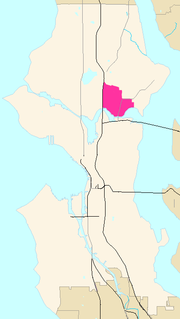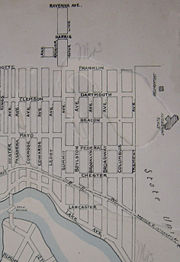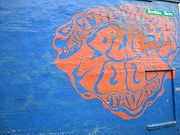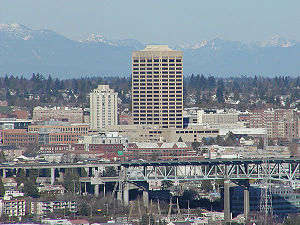
University District, Seattle, Washington
Encyclopedia

University of Washington
University of Washington is a public research university, founded in 1861 in Seattle, Washington, United States. The UW is the largest university in the Northwest and the oldest public university on the West Coast. The university has three campuses, with its largest campus in the University...
(UW) is located there. The UW moved in two years after the area was annexed to Seattle, while much of the area was still clear cut forest or stump farmland. The district of neighborhoods grew with the university to become like a smaller version of urban American cities.
Location

Interstate 5
Interstate 5 is the main Interstate Highway on the West Coast of the United States, running largely parallel to the Pacific Ocean coastline from Canada to Mexico . It serves some of the largest cities on the U.S...
; on the east by 25th Avenue NE; on the south by the Lake Washington Ship Canal
Lake Washington Ship Canal
The Lake Washington Ship Canal, which runs through the City of Seattle, Washington, connects the fresh water body of Lake Washington with the salt water inland sea of Puget Sound. The Ship Canal includes a series of locks, modeled after the Panama Canal, to accommodate the different water levels...
; and on the north by NE Ravenna Boulevard. It also includes, east of these boundaries, a small district on the north shore of Union Bay
Union Bay (Seattle)
Union Bay is that part of Lake Washington in Seattle that is west of a line drawn between Webster Point in the Laurelhurst neighborhood to the north and Foster Point in the Madison Park neighborhood to the south...
, bounded on the north by NE 45th Street and on the east by 35th Avenue NE. This extension consists mainly of the "east campus" and extensive parking lots of the University. Its main commercial street, University Way NE, is known throughout the city as "The Ave
The Ave
University Way NE, colloquially The Ave , is the commercial heart of the University District and the off-campus extension of the University of Washington in Seattle. Once "a department store eight blocks long," The Ave has gradually turned into what now resembles an eight-block-long global food...
" in the "U District".
Some parts of the University District have had names of their own. For example, today "University Heights" mainly designates a former school used as a community center; a 1905 map shows the name as applying specifically to the area bounded by what are now NE 45th Street to the south, NE 55th Street to the north, Brooklyn Avenue NE to the west, and 15th Avenue NE to the east.
History
What is now the University District has been inhabited since the end of the last glacial period (c. 8,000 BCE—10,000 years ago). Prominent Native AmericanNative Americans in the United States
Native Americans in the United States are the indigenous peoples in North America within the boundaries of the present-day continental United States, parts of Alaska, and the island state of Hawaii. They are composed of numerous, distinct tribes, states, and ethnic groups, many of which survive as...
Duwamish villages of the Lushootseed (Skagit-Nisqually)
Lushootseed
Lushootseed is the language or dialect continuum of several SalishNative American groups of modern-day Washington state...
Coast Salish
Coast Salish
Coast Salish languages are a subgroup of the Salishan language family. These languages are spoken by First Nations or Native American peoples inhabiting the territory that is now the southwest coast of British Columbia around the Strait of Georgia and Washington state around Puget Sound...
nations were on a then-larger Portage Bay at what is now called Brooklyn Avenue, and the other on a larger Union Bay, near the present UW power plant (which is across from the UW IMA building), around the north shores a mile farther than today, and shores east of what is now the Union Bay Natural Area
Union Bay Natural Area
The Union Bay Natural Area in in Seattle, Washington, also known as Union Bay Marsh, is the restored remainder of the filled former Union Bay and Union Bay Marsh after University Village Shopping Center, the University of Washington athletic facilities, buildings, and main parking area...
. (See also adjacent Ravenna neighborhood.) The Duwamish, ("People of the Inside") tribe had the prominent village of SWAH-tsoo-gweel ("portage") on then-adjacent Union Bay, and what is now Ravenna was their backyard before the arrival of European settlers. Villages were diffuse. In spring, people dispersed from their winter villages of longhouses to camps, gathering in summer for salmon. Gaps in the forest were maintained to encourage game and food supplies. Such "prairies" (anthrogenic grassland
Grassland
Grasslands are areas where the vegetation is dominated by grasses and other herbaceous plants . However, sedge and rush families can also be found. Grasslands occur naturally on all continents except Antarctica...
s) were cultivated in what is now the University District. They were connected by a well-travelled path along what is now the Lake Washington Ship Canal (1883, 1916).
Surveyors noted several large Douglas-firs
Coast Douglas-fir
Pseudotsuga menziesii, known as Douglas-fir, Oregon Pine, or Douglas spruce, is an evergreen conifer species native to western North America. Its variety Pseudotsuga menziesii var. menziesii, also known as coast Douglas-fir grows in the coastal regions, from west-central British Columbia, Canada...
and western red cedars
Thuja plicata
Thuja plicata, commonly called Western or pacific red cedar, giant or western arborvitae, giant cedar, or shinglewood, is a species of Thuja, an evergreen coniferous tree in the cypress family Cupressaceae native to western North America...
(given that large trees were not unusual back then, these must have been especially large). The U. District was first surveyed in 1855, and its first white settlers arrived 12 years later. In 1890, that part of the neighborhood due west of the present UW campus was laid out as the Brooklyn Addition. One year later much of the land north of the Ship Canal, including Brooklyn, was annexed to Seattle. The UW moved from Downtown in 1893, and the first university building was built in 1895.
An 1894 report describes a train wreck just west of the current University District. Latona has now been cut off from the University by Interstate 5.
August 20, 1894. Wreck on [the] Seattle, Lake Shore and Eastern just west of Latone [now Latona Avenue]. Freight train from Gilman [now SnoqualmieSnoqualmie, WashingtonSnoqualmie is a city next to Snoqualmie Falls in King County, Washington. The city is home to the Northwest Railway Museum. The population was of 10,670 at the 2010 census...] hit a cow. [Trainload was a] [m]ixer freight train, 10 co[a]l cars, logs and box cars. Train had slowed down at Brooklyn [Avenue] for cows. Engineer saw cows on a bank beyond Latona looking (?) one another[!]. One cow was tossed over [the] bank and hit the track just as [the] engine came by. [The] [e]ngine was raised off the track[,] and when it came down [the] wheels went off the rails. Engineer reversed but [it] was too late. [The] [c]oal tender shot ahead[,] tearing part of [the engine] car [(cab)] off and decapitating [the] fireman and killing [the] brakeman. Engineer and coal passer [were] unhurt. Steam and dust enveloped the derailed cars. Engineer ran to Fremont to telegraph to stop [the] evening passenger train[;] also [illegible] Engineer claimed train going 20 miles per hr.

But for the trolley, in early decades of the U. District Downtown was a trek, a boat, and a horsecart ride away. Given these early transportation difficulties, the U. District was largely self-sufficient, with area businesses for people with ties to the University. Construction of family homes increased in the early 1900s, as did churches, theaters, stores, and a YMCA
YMCA
The Young Men's Christian Association is a worldwide organization of more than 45 million members from 125 national federations affiliated through the World Alliance of YMCAs...
. The district's first bank and the first local public library opened in 1906, the modest library organized by local merchants.
As a result of a contest held by the University Commercial Club in 1919, 14th Avenue (by then already known as "The Avenue" or "The Ave
The Ave
University Way NE, colloquially The Ave , is the commercial heart of the University District and the off-campus extension of the University of Washington in Seattle. Once "a department store eight blocks long," The Ave has gradually turned into what now resembles an eight-block-long global food...
") was renamed University Way, and the neighborhood was renamed the University District (1919). The neighborhood's north-south arterials are (from west to east) Roosevelt Way NE (southbound)), 11th Avenue NE (northbound), Brooklyn Avenue NE, University Way NE, and 15th Avenue NE. NE Pacific, 45th, and part of 50th streets are principal east-west arterials, NE Campus Parkway is a minor east-west arterial, running only west of the campus.
Contemporary

Blue Moon Tavern
The Blue Moon is a tavern located on the west edge of the University District, Seattle, Washington, that has been visited by many counterculture icons over the years. It opened in April 1934, soon after the repeal of Prohibition in December 1933, as the first and oldest still-extant tavern in the...
has become an unofficial cultural landmark, since 1934. Big Time is Seattle's original brewpub (1988). Opened in 1966 Dante's Bar&Nightclub is another popular venue and is known as "a U-District tradition." Six theatres (including the Neptune built in 1921, the Varsity since 1940; the Grand Illusion Cinema
Grand Illusion Cinema
The Grand Illusion Cinema is the longest running independent cinema in the city of Seattle, Washington in the United States of America, and has become a landmark of the film community. Opened in 1968 by Randy Findley in a converted dentist’s office the cinema became the city’s first arthouse and...
(founded in a former dental lab in 1968 by Randy Finley, now owned and run by dedicated volunteers); and the (locally-owned) Scarecrow Video
Scarecrow Video
Scarecrow Video is an independently owned video sales and rental store.Located in the University District of Seattle, Washington, the store was opened in 1988 by Rebecca and George Latsios. It currently stocks over 100,000 titles, many of them out of print...
, the largest video store on the West Coast further characterize the neighborhood. The U District is second only to Capitol Hill
Capitol Hill, Seattle, Washington
Capitol Hill is the most densely populated residential district in Seattle, Washington, United States. It is the center of the city's gay and counterculture communities, and is one of the city's most prominent nightlife and entertainment districts....
as an epicenter for NoCat http://nocat.net/ Free Wi-Fi
Wi-Fi
Wi-Fi or Wifi, is a mechanism for wirelessly connecting electronic devices. A device enabled with Wi-Fi, such as a personal computer, video game console, smartphone, or digital audio player, can connect to the Internet via a wireless network access point. An access point has a range of about 20...
with the global Seattle Wireless http://www.seattlewireless.net/FrontPage project.
The neighborhood's skyline landmarks (other than the UW campus) are its tallest buildings: UW Tower
UW Tower
University of Washington Plaza is a skyscraper complex completed in 1975 in the University District of Seattle, Washington. The , 22-storey tower, designed by NBBJ, is the tallest building outside of Downtown Seattle area. The tower was originally constructed as Safeco Plaza to serve as Safeco...
(formerly Safeco Plaza) and the Meany Hotel (which became the Best Western University Tower and is now known as Hotel Deca). The former, originally headquarters of Safeco Corporation, is located at the corner of Brooklyn Avenue NE and NE 45th Street. It was built in 1973, and at 22 stories high is the city's tallest building outside Downtown. The latter is Art Deco (1931, restored). The architect Robert Reamer gave every room a corner window. A jewel of the neighborhood is the formal Neo-classical Carnegie Library (1910) on Roosevelt Way at 50th Street.

University Village, Seattle, Washington
University Village is an upscale shopping center in Seattle, Washington, built at the south corner of Ravenna neighborhood. The 24 acre shopping center was built in 1956 across NE 45th Street on an earlier part of the Montlake Landfill University Village is an upscale shopping center in Seattle,...
shopping center east of the campus, and Northgate Mall
Northgate Mall (Seattle)
Northgate Mall is a shopping mall in the Northgate district of north urban Seattle, Washington. It is currently anchored by Bed Bath & Beyond, Toys "R" Us, JCPenney, Macy's and Nordstrom.-History:...
about 1-1/2 miles (2-1/2 km) north beside I-5
Interstate 5
Interstate 5 is the main Interstate Highway on the West Coast of the United States, running largely parallel to the Pacific Ocean coastline from Canada to Mexico . It serves some of the largest cities on the U.S...
. From 2002 to 2004, the city and the neighborhood have made some steps countering this trend by giving the Ave a repaving facelift including the addition of benches, bus bulb
Bus bulb
A bus bulb, also called a bus boarder or bus border, is an arrangement by which a sidewalk is extended outwards for a bus stop; typically the bus bulb replaces roadway that would otherwise be part of a parking lane...
s, and period lighting. The addition of benches represented the reversal of a decades-long neighborhood trend away from providing free places to sit.
Starting in 2016, the district will be serviced by an extension of Link Light Rail
Link Light Rail
Sound Transit Link Light Rail is a rapid transit project in the Greater Seattle region, originally approved by a ballot measure in November 1996. Two lines are currently operating as of 2009: Tacoma Link, which uses 3 vehicles built by Škoda, and Central Link, which uses 35 vehicles built by Kinki...
called the University Link
University Link
University Link is a future light rail extension of Sound Transit's Link light rail system in Seattle, Washington, USA. The line will connect downtown Seattle with the University of Washington via Capitol Hill. The line was approved by the Federal Transit Administration in November 2006...
. The light rail
Light rail
Light rail or light rail transit is a form of urban rail public transportation that generally has a lower capacity and lower speed than heavy rail and metro systems, but higher capacity and higher speed than traditional street-running tram systems...
line will connect the U District with Capitol Hill
Capitol Hill, Seattle, Washington
Capitol Hill is the most densely populated residential district in Seattle, Washington, United States. It is the center of the city's gay and counterculture communities, and is one of the city's most prominent nightlife and entertainment districts....
, Downtown Seattle
Downtown Seattle
Downtown is the central business district of Seattle, Washington. It is fairly compact compared to other city centers on the West Coast because of its geographical situation: hemmed in on the north and east by hills, on the west by the Elliott Bay, and on the south by reclaimed land that was once...
, Rainier Valley
Rainier Valley, Seattle, Washington
The Rainier Valley neighborhood in Seattle, is located east of Beacon Hill; west of Mount Baker, Seward Park, and Leschi; south of the Central District and First Hill; and north of the city line...
, and Sea-Tac airport
Seattle-Tacoma International Airport
The Seattle–Tacoma International Airport , also known as Sea–Tac Airport or Sea–Tac , is an American airport located in SeaTac, Washington, at the intersections of State Routes 99 and 509 and 518, about west of Interstate 5...
. There are currently plans for one station located on Montlake Boulevard in front of Husky Stadium
Husky Stadium
Husky Stadium is an outdoor athletic stadium on the campus of the University of Washington in Seattle, Washington, United States. It is the home of the Washington Huskies...
and another on Brooklyn.
The local year-round and seasonal homeless
Homelessness
Homelessness describes the condition of people without a regular dwelling. People who are homeless are unable or unwilling to acquire and maintain regular, safe, and adequate housing, or lack "fixed, regular, and adequate night-time residence." The legal definition of "homeless" varies from country...
population, referred to as "Ave Rats", is well-known around Seattle. (See The Ave.)
Due to the size of the UW Greek system, fraternity and sorority
Fraternities and sororities
Fraternities and sororities are fraternal social organizations for undergraduate students. In Latin, the term refers mainly to such organizations at colleges and universities in the United States, although it is also applied to analogous European groups also known as corporations...
members make up a sizeable portion of the local cafes' and bars' clientele, especially such establishments as Earl's and Fourno's, though well outnumbered by the Seattle campus student body of more than 39,250. Other bars have a wider base of patrons, including the College Inn (built for the Alaska-Yukon Exposition in 1909) and the Irish Emigrant. The University District is home to all of the UW's fraternity and sorority houses, most of them clustered along 17th Avenue NE between NE 45th and 50th Streets ("Frat Row" or "Greek Row"). On Thursday (when many Greek parties are held to deter high-schoolers) and Friday nights, it is not uncommon for parties to spill out into the local streets within the area. This reputation draws many crashers, and most of the recent instances of gun violence
Gun violence
Gun violence defined literally means the use of a firearm to threaten or inflict violence or harm. Gun violence may be broadly defined as a category of violence and crime committed with the use of a firearm; it may or may not include actions ruled as self-defense, actions for law enforcement, or...
, injury, and property damage at UW student parties have been due to party crashers getting ejected, in the context of readily available alcohol (and recreational drugs) at large student parties.
See also
- The AveThe AveUniversity Way NE, colloquially The Ave , is the commercial heart of the University District and the off-campus extension of the University of Washington in Seattle. Once "a department store eight blocks long," The Ave has gradually turned into what now resembles an eight-block-long global food...
- Last Exit on BrooklynLast Exit on BrooklynThe Last Exit on Brooklyn was a Seattle University District coffeehouse established in 1967 by Irv Cisski. It opened on June 30, 1967 at 3930 Brooklyn NE near the University of Washington campus in a small light-industrial building leased from the University...
- Museum Without Walls

